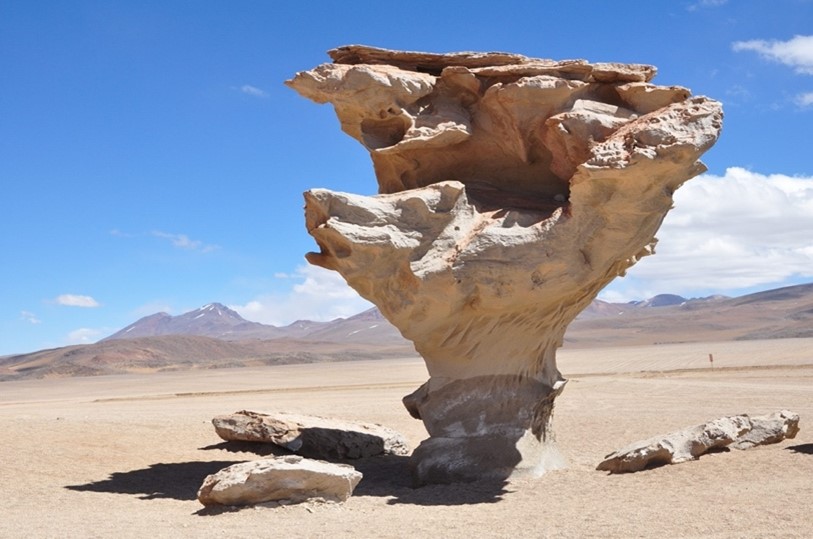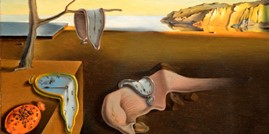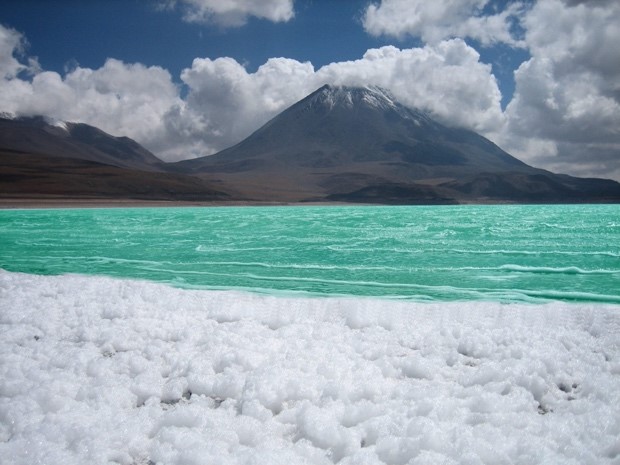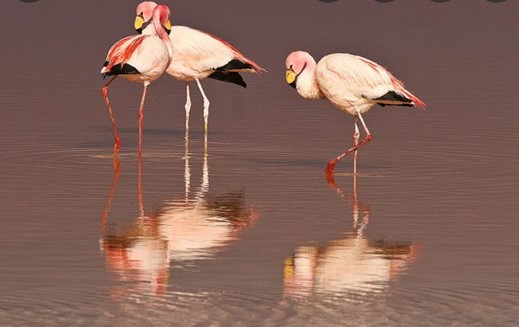Go to ESP
BOLIVIA
We travel, among other things, to escape from the sounds of our city. Don't get me wrong: I love the sounds of my city. The car horns and the fire trucks’ sirens accompany me along each step I take, they have taught me to sleep despite the noise when I used to live in crowded areas, recently replaced by the birds that draw sounds through my window now that I live in a suburban neighborhood. Near the sea, the murmur of the waves whispers memories of childhood. In the dark, if I listen carefully, I can hear within the silence of the early morning the whistle of a distant train, almost ghostly. I love the sounds of my city, between the noise and the music there is a neutral and constant frequency that lodges in my ears and to which I am already accustomed.
But every now and then I want to escape...Traveling is a feast for the senses, from the innumerable flavors that we experience trying different cuisines to the landscapes, horizons and sunsets that remain etched in our retina. All our senses are alert to the vibrations of the plane, to the slightest changes of temperature, to the smells that hit our face when leaving an airport in a city yet to be discovered. We tested the texture of the hotel sheets, we looked out the window to see the buildings, we were astonished to discover that the water tastes different in each place, always.
But once all the excitement resulting from the start of a new trip begins to decrease, when we have finished exchanging impressions with our partner or family members, when it is time to stay still, that is the moment when the sounds make their appearance in all their splendor and swamp our existence. There is no way to escape, we are going to visit each tourist destinations hand in hand with the sounds.
EscapeBut what happens when we arrive to a place so remote, so strange, and suddenly we discover silence? South of Bolivia, on the border with the Atacama desert, at an incredible four thousand five hundred meters high, between volcanoes and lagoons, fumaroles and flamingos, lays the Eduardo Avaroa Andean Fauna National Reserve. When we get used to dry lips, the strong smells, the imposing sight and the inevitable cold weather, we become aware of the absence of sounds: there are no cars, no noise, only the wind speaks, some animal sings, but silence reigns, peace; we have escaped the sounds, this is a pause in our lives.
In the middle of the Atacama desert there is an oasis, and next to that oasis, there is a city called Calama. In 1879, when it was still Bolivian territory, the War of the Pacific had began and 500 soldiers of the Chilean troops were heading to the town of Calama to take it due to its strategic importance as a link between the mountains and the sea, where various mining products passed through. A hundred men, most of them volunteers, were ready to defend the town, and although they were inevitably defeated, one of these volunteers, armed with a Winchester rifle, dug in and delayed the advance of the army for many hours. The Chilean colonel, considering his attitude worthy of a true patriot, offered him surrender to spare his life, but the man, already out of ammunition, came out of hiding and yelled:
JORGE: “I'll never give up, damn it, let your grandmother give up!”
He is Jorge Campos, a Bolivian guide at the Eduardo Avaroa Reserve.
JORGE: It is there where Eduardo Avaroa dies, and from there Eduardo Avaroa becomes a national hero. The information is not very clear. If you go to Chile, they will tell you the opposite. In Bolivia, Eduardo Avaroa is a national hero, but beyond the Chilean frontier, Eduardo Avaroa is considered a hero of the Antofagasta region.
However, streets, avenues, squares and even entire provinces bear the name of Eduardo Avaroa throughout Bolivia, not to mention that coins have been minted with his face, stamps include his famous phrase and, of course, statues commemorating their moment of glory adorn parks and gardens. It is not surprising, hence, that the most important National Reserve in Bolivia is named after him.
Surrounded by dozens of peaks and volcanoes, ranging from 4,800 to almost 6,000 meters, the Eduardo Avaroa Reserve is a hidden gem in the middle of the Andes. This high-altitude, stony desert area has had little tourist influx so far, mainly due to its difficult access. It is almost like a prehistoric landscape, where the time of humans has yet to arrive. To the lack of paved roads, other deficiencies such as hotel and service infrastructure are added. It is a vicious circle: as there is no tourist infrastructure there are not so many visitors, and since there are not so many visitors, why put it in value by creating infrastructure. For now, let us agree that the absence of mass tourism allows the ecosystem to be maintained.
This desert landscape is sometimes interrupted either by stone forests, either by fumaroles with intense smells, or by colorful lagoons. But let's go bit by bit: north of the Reserve lays the Siloli desert, one of the driest in the world. Here, where rainwater is and has been scarce for millions of years, there are tall structures of volcanic stone, carved by the wind, called as a whole a stone forest. One of these structures stands out in a singular way, five meters high, thin at the base and wide at the top.

This natural sculpture that rises capriciously in the middle of the desert and where there is no vegetation whatsoever, receives the friendly name of "stone tree".
We go a little further into the reserve and we come across a scene from another world, totally alien to our reality. Perhaps that is why they have named this part of the desert as “Salvador Dalí”.
JORGE: Actually, the real name given to the Salvador Dalí desert is not such, it is the Pampajara desert. But when the visitors arrived, they have come to compare the landscape, similar to a painting of Salvador Dalí.

Jorge refers to “The persistence of memory” by Salvador Dalí, that famous painting with clocks melting on the branches of a dry tree. But, in order to find the similarities we have to look at the upper right corner of the painting, where a rocky formation has the looks and colors very similar to those of the desert. But we need to emphasize something else: Dalí never knew of the existence of this desert, which makes this similarity even more surprising.

JORGE: From the Salvador Dalí desert, you have to go through the hot springs of Polques and the Laguna Salada.
And twenty-five minutes from there are the geysers...
JORGE: They are not actually geysers, they are fumaroles.
A fumarole is a place where the concentration of geothermal energy is expelled through the spaces or cracks and steam can be seen.
These fumaroles are known as Morning Sun.
JORGE: Why Morning Sun? Because is visited from five in the morning, five thirty, before the sun rises, when geothermal activity in that area is much more intense. Then, the contrast of the low temperature from the cold breeze and the hot surface cause the steam that comes out of the deep to dissipate high up in the surroundings. It is a place where you can see a variety of color contrast. You can see the ochre color, sulfur oxide, iron oxide. Then when the sun rises it is painted in colors and the geothermal activity increases the excitement. It's like leaping to… it's like going back to the past in order to be there.
But the highlight of the reserve are undoubtedly the lagoons, called simply by the colors that dye them: White Lagoon, Green Lagoon, Red Lagoon. There are others with less simplistic names such as Busch Lagoon or Stinky Lagoon. But we are going to focus on the colored ones, since they are the best known and the most visited.
When we arrive at the White Lagoon we can easily get confused and think that we are facing a similar phenomenon to that of the Salar de Uyuni or other landscapes where the salt is the one that dyes in white everything, turning the entire surface into a perfect mirror that imitates the mountain range, the horizon and the sky in its waters. But it is not salt but borax, which is used mainly for the cleaning and jewelry industry. Here nothing grows or lives, there are no birds, there are no plants, nothing, only the Licancabur volcano, which means "mountain of the people”, watches us majestically, silently, from the western mountain range of the Andes. Its last eruption was more than ten thousand years ago.
Connected to the White Lagoon by a small strait and always at the foot of the Licancabur is also the Green Lagoon.
JORGE: During the day a lagoon with crystalline waters, but when the wind starts from east to west, from north and south...
Winds that exceed a hundred kilometers per hour.

JORGE: Small whirls of wind and sand are formed, stirring the water and all the concentrated metals under such as oxides, magnesium and sulfur. These minerals are brought to the surface and the water gradually takes on a hue of an emerald green color.

Before heading towards the Red Lagoon, it is necessary to make a parenthesis. There will be those who have realized that the full name of this reserve is Eduardo Avaroa National Reserve of Andean Fauna, but at this point we have not yet mentioned any animal or plant. What happens is that the high altitude, the low temperatures, the absence of fresh water and the lack of nutrients are responsible that both plants and animals went through a very complex adaptation process that allows them to withstand these harsh conditions.
It is estimated that there are more than 190 species of plants throughout the reserve, mainly grasslands and cacti. Special mention deserves the yareta, a very dense shrub, which grows at the incredible speed of one centimeter per year, each plant living for more than one hundred years. There is something indescribable that happens inside of us when we meet a plant in the middle of nowhere, which has survived, let's say fifty years there, in almost absolute solitude, ready to continue for 50 more years in the same situation.
Fauna is much more attractive and interesting.
JORGE: From three thousand six hundred meters to six thousand meters you can see a great variety of fauna. At the lower areas you can see the vicuña, the Andean vicuña. You can see also the fox. We go up a little more towards three thousand nine hundred, four thousand meters and you can see the suri.
Which is a kind of ostrich from the Andes. There are also Andean foxes and vizcachas in large numbers.
JORGE: Even an Andean puma. But reaching almost five thousand, four thousand three hundred and seventy meters above sea level you get to see flamingos in a large number in different sectors of the lagoons.

Of the six varieties of flamingos in the world, three of them can be found in the reserve: the Andean flamingo, the Chilean flamingo and the James flamingo. In fact, is precisely at the Red Lagoon where its presence is most common.
According to the information obtained through monitoring systems, flamingos have migration patterns that cover from Argentine Patagonia to the highlands and the coast of Peru.
Some go to Chile, others to the Salar de Uyuni or other areas of Bolivia. It is always a unique experience to see a group of flamingos on the seashore, to see them cross the horizon in small flocks. But what you see at the Red Lagoon is something that exceeds all expectations. Thousands, and I'm not exaggerating, flock to these shallow waters to feed on tiny shrimp and care for their little springs.
SilenceAnd suddenly we realize that this is it, that it took us to travel the world, not only in distance but to cross inhospitable and strange landscapes, take a glimpse of the past, visit places full of toxicity where there is no living being that inhabits it or experience the smell of sulfur at its finest, but we arrived here. We are on the roof of the world. The volcanoes watch us and take care of us. There is nothing to say, there is nothing to hear. As I said before, the wind still sounds, the flamingos still sing to each other, but there is an equilibrium, a balance. We had to escape the sounds of the city to find this silence.